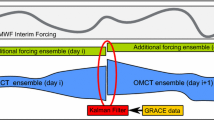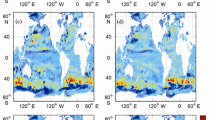Abstract
The data assimilation (DA) of satellite observations of the ocean level from the Archiving Validating and Interpolating Satellite Observations (AVISO) into the IWM model (G.I. Marchuk Institute of Computational Mathematics) of the Russian Academy of Sciences is considered. An original DA method is used that generalizes the well-known Kalman algorithm, called by the authors the Generalized Kalman filter (GKF). Various fields of model characteristics are constructed and analyzed in the South Atlantic region, in particular, level fields, ocean surface temperature (OST) and current velocity fields on the surface. Their spatiotemporal variability is studied before and after the assimilation of observational data. The spatiotemporal variability of the model and observed level and temperature of the ocean surface in the South Atlantic is also compared. The similarities and differences of these fields are analyzed. The comparisons with other models confirm the adequateness of the ocean field simulation with the help of the DA method.







Similar content being viewed by others
REFERENCES
V. I. Agoshkov, E. I. Parmuzin, and V. P. Shutyaev, “Numerical algorithm for variational assimilation of sea surface temperature data,” Comput. Math. Math. Phys. 48, 1293–1312 (2008). https://doi.org/10.1134/S0965542508080046
K. P. Belyaev, A. A. Kuleshov, I. N. Smirnov, and C. A. S. Tanajura, “Comparison of data assimilation methods in hydrodynamics ocean circulation models,” Math. Models Comput. Simul. 11, 564–574 (2019). https://doi.org/10.1134/S2070048219040045
K. P. Belyaev, C. A. S. Tanajura, and N. P. Tuchkova, “Comparison of methods for ARGO drifters data assimilation into a hydrodynamical model of the ocean,” Oceanology (Engl. Transl.) 52, 593–603 (2012). https://doi.org/10.1134/S0001437012050025
L. S. Gandin, Objective Analysis of Meteorological Fields (Gidrometeoizdat, Leningrad, 1963) [in Russian].
I. I. Gikhman and A. V. Skorokhod, Introduction to the Theory of Random Processes (Mir, Moscow, 1977; Dover, New York, 1996).
I. D. Deinego1, I. Ansorge, K. P. Belyaev, and N. A. Dianskii, “Spatial-temporal variability of the model characteristics in the Southern Atlantic,” Morsk. Gidrofiz. Zh. 35 (6), 549–562 (2019). https://doi.org/10.22449/0233-7584-2019-6-572-584
V. V. Knysh, S. G. Demyshev, G. K. Korotaev, and A. S. Sarkisyan, “Method and results of assimilation of climatic data on temperature, salinity, and sea level into a numerical model of the Black Sea,” Izv., Atmos. Ocean. Phys. 43, 363–377 (2007). https://doi.org/10.1134/S0001433807030115
G. I. Marchuk, B. E. Paton, G. K. Korotaev, and V. B. Zalesny, “Data-computing technologies: a new stage in the development of operational oceanography,” Izv., Atmos. Ocean. Phys. 49, 579–591 (2013). https://doi.org/10.1134/S000143381306011X
E. G. Morozov, A. N. Demidov, and R. Yu. Tarakanov, “Transport of Antarctic waters in the deep channels of the Atlantic Ocean,” Dokl. Earth Sci. 423, 1286–1289 (2008).
A. V. Remeslo, E. G. Morozov, V. G. Neiman, and P. P. Chernyshkov, “Structure and variability of the Falkland Current,” Dokl. Earth Sci. 399, 1156–1159 (2004).
V. A. Rozhkov, Statistical Hydrometeorology, Part 1: Thermodynamics (St. Petersburg State Univ., St. Petersburg, 2013) [in Russian].
A. A. Samarskii and A. P. Mikhailov, Mathematical Modeling: Ideas, Methods, and Examples, 2nd ed. (Fizmatlit, Moscow, 2001) [in Russian]. ISBN 5-9221-0120-X
K. Belyaev, A. Kuleshov, N. Tuchkova, and C. A. Souza Tanajura, “An optimal data assimilation method and its application to the numerical simulation of the ocean dynamics,” Math. Comput. Model. Dyn. Syst. 24 (1), 12–25 (2018). https://doi.org/10.1080/13873954.2017.1338300
K. Belyaev and C. A. Souza Tanajura, “On the correction of perturbations due to data assimilation in ocean circulation models,” Appl. Math. Model. 29 (7), 690–709 (2005). https://doi.org/10.1016/j.apm.2004.10.001
G. Evensen, Data Assimilation: The Ensemble Kalman Filter (Springer-Verlag, Berlin, 2009). https://doi.org/10.1007/978-3-642-03711-5.
M. Ghil and P. Malanotte-Rizzoli, “Data assimilation in meteorology and oceanography,” Adv. Geophys. 33, 141–266 (1991). https://doi.org/10.1016/S0065-2687(08)60442-2
V. Gouretski and F. Reseghetti, “On depth and temperature biases in bathythermograph data: Development of a new correction scheme based on analysis of a global ocean database,” Deep Sea Res., Part I 57, 812–833 (2010). https://doi.org/10.1016/j.dsr.2010.03.011
R. Kalman, “A new approach to linear filtering and prediction problems,” ASME J. Basic Eng. 82, 35–45 (1960). https://doi.org/10.1115/1.3662552
E. Kalnay, M. Kanamitsu, R. Kistler, et al., “The NCEP/NCAR 40-year reanalysis project,” Bull. Am. Meteorol. Soc. 77 (3), 437–472. 1996). https://doi.org/10.1175/1520-0477(1996)077<0437:TNYRP>2.0.CO;2
E. Kalnay, Y. Ota, T. Miyoshi, and J. Liu, “A simpler formulation of forecast sensitivity to observations: application to ensemble Kalman filters,” Tellus A 64 (1), (2012). https://doi.org/10.3402/tellusa.v64i0.18462
M. Kaurkin, R. Ibraev, and K. Belyaev, “Assimilation of the AVISO altimetry data into the ocean dynamics model with a high spatial resolution using ensemble optimal interpolation (EnOI),” Izv., Atmos. Ocean. Phys. 54, 56–64 (2018). https://doi.org/10.1134/S0001433818010073
W. G. Large and S. G. Yeager, “The global climatology of an interannually varying air–sea flux data set,” Clim. Dyn. 33, 341–364 (2009). https://doi.org/10.1007/s00382-008-0441-3
G. I. Marchuk and V. B. Zalesny, “A numerical technique for geophysical data assimilation problem using Pontryagin’s principle and splitting-up method,” Russ. J. Num. Anal. Math. Model. 8, 311–326 (1993). https://doi.org/10.1515/rnam.1993.8.4.311
G. Marchuk and V. Zalesny, “Modeling of the World Ocean circulation with the four-dimensional assimilation of temperature and salinity fields,” Izv., Atmos. Ocean. Phys. 48, 15–29 (2012). https://doi.org/10.1134/S0001433812010070
E. G. Morozov, R. Yu. Tarakanov, T. A. Demidova, et al., “Velocity and transport of the Falkland Current at 46° S,” Russ. J. Earth Sci. 16, ES6005 (2016). https://doi.org/10.2205/2016ES000588
S. Moshonkin, V. Zalesny, and A. Gusev, “Simulation of the Arctic—North Atlantic ocean circulation with a two-equation k-omega turbulence parameterization,” J. Mar. Sci. Eng. 6 (95), (2018). https://doi.org/10.3390/jmse6030095
A. Piola and R. Matano, “Ocean currents: Atlantic Western Boundary—Brazil Current/Falkland (Malvinas) Current,” in Reference Module in Earth Systems and Environmental Sciences (Elsevier, Amsterdam, 2017). https://doi.org/10.1016/B978-0-12-409548-9.10541-X
P. Sakov, F. Counillon, L. Bertino, et al., “TOPAZ4: an ocean-sea ice data assimilation system for the North Atlantic and Arctic,” Ocean Sci. 8 (4), 633–656 (2012). https://doi.org/10.5194/os-8-633-2012
A. Schiller and G. B. Brassington, Operational Oceanography in the 21st Century (Springer, Dordrecht, 2011). https://doi.org/10.1007/978-94-007-0332-2
C. A. Souza Tanajura, D. Mignac, A. Novaes Santana, et al., “Observing system experiments over the Atlantic Ocean with the REMO ocean data assimilation system (RODAS) into HYCOM,” Ocean Dyn. 70, 115–138 (2019). https://doi.org/10.1007/s10236-019-01309-8
C. A. Souza Tanajura, A. Novaes Santana, D. Mignac, et al., “The REMO ocean data assimilation system into HYCOM (RODAS_H): general description and preliminary results,” Ocean. Atmos. Res. Lett. 7 (5), 464–470 (2014). https://doi.org/10.3878/j.issn.1674-2834.14.0011
Funding
This study was carried out under the state assignment of the Institute of Oceanology, Russian Academy of Sciences No. 0128-2021-0002 with the support of the Russian Foundation for Basic Research, grant No. 19-57-60 001 (model calculations). I. Ansorg’s work was supported by grant UID 118901 from the National Science Foundation of the Republic of South Africa.
Author information
Authors and Affiliations
Corresponding author
Additional information
Translated by G. Karabyshev
Rights and permissions
About this article
Cite this article
Deinego, I.D., Ansorge, I. & Belyaev, K.P. Altimetry Data Assimilation Into a Numerical Model of Ocean Dynamics in the South Atlantic. Oceanology 61, 613–624 (2021). https://doi.org/10.1134/S0001437021050039
Received:
Revised:
Accepted:
Published:
Issue Date:
DOI: https://doi.org/10.1134/S0001437021050039




